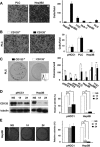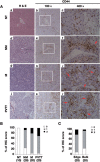The critical role of CD133(+)CD44(+/high) tumor cells in hematogenous metastasis of liver cancers
- PMID: 21862973
- PMCID: PMC3351911
- DOI: 10.1038/cr.2011.139
The critical role of CD133(+)CD44(+/high) tumor cells in hematogenous metastasis of liver cancers
Abstract
Metastatic hepatocellular carcinoma (HCC) is one of the most lethal cancers worldwide. However, the cell population responsible for its metastasis remains largely unknown. Here, we reported that CD133(+)CD44(+/high) defined a subgroup of tumor cells that was responsible for hematogenous metastasis of liver cancers. Immunohistochemical investigation of human HCC specimens revealed that the number of CD133(+) and CD44(+) HCC cells was increased and was associated with portal vein invasion. Purified CD133(+) or CD44(high) HCC cells were superior in clonogenic growth and vascular invasion, respectively. Thus, the combination of CD133 and CD44 was used to define a novel HCC sub-population. CD133(+)CD44(high), but not CD133(+)CD44(low/-), CD133(-)CD44(high) or CD133(-)CD44(low/-) xenografts, produced intrahepatic or lung metastasis in nude mice. Further analysis of human HCC samples by flow cytometry showed that the number of CD133(+)CD44(+) tumor cells was associated with portal vein metastasis. The cDNA microarray analysis of CD133(+)CD44(+) and CD133(+)CD44(-) tumor cells isolated from metastatic HCC patients revealed that these cells comprised of two different populations possessing distinct gene expression profiles. Our results suggest that CD133(+)CD44(+) tumor cells are a particular population responsible for hematogenous metastasis in liver cancers and that these cells might be targets for treatment of HCC metastasis.
Figures







Similar articles
-
Immunohistochemical staining of cancer stem cell markers in hepatocellular carcinoma.Exp Mol Pathol. 2010 Aug;89(1):27-35. doi: 10.1016/j.yexmp.2010.05.005. Epub 2010 May 16. Exp Mol Pathol. 2010. PMID: 20511115 Free PMC article.
-
Highly enriched CD133(+)CD44(+) stem-like cells with CD133(+)CD44(high) metastatic subset in HCT116 colon cancer cells.Clin Exp Metastasis. 2011 Dec;28(8):751-63. doi: 10.1007/s10585-011-9407-7. Epub 2011 Jul 13. Clin Exp Metastasis. 2011. PMID: 21750907
-
Expression of CD133 confers malignant potential by regulating metalloproteinases in human hepatocellular carcinoma.J Hepatol. 2010 Jun;52(6):872-9. doi: 10.1016/j.jhep.2009.12.030. Epub 2010 Mar 24. J Hepatol. 2010. PMID: 20395004
-
Biology and clinical implications of CD133(+) liver cancer stem cells.Exp Cell Res. 2013 Jan 15;319(2):126-32. doi: 10.1016/j.yexcr.2012.09.007. Epub 2012 Sep 19. Exp Cell Res. 2013. PMID: 22999864 Review.
-
Lessons from common markers of tumor-initiating cells in solid cancers.Cell Mol Life Sci. 2011 Dec;68(24):4009-22. doi: 10.1007/s00018-011-0772-9. Epub 2011 Jul 24. Cell Mol Life Sci. 2011. PMID: 21786143 Free PMC article. Review.
Cited by
-
Targeted multimodal nano-reporters for pre-procedural MRI and intra-operative image-guidance.Biomaterials. 2016 Dec;109:69-77. doi: 10.1016/j.biomaterials.2016.09.013. Epub 2016 Sep 19. Biomaterials. 2016. PMID: 27673597 Free PMC article.
-
Cellular and Molecular Biology of Cancer Stem Cells of Hepatocellular Carcinoma.Int J Mol Sci. 2023 Jan 11;24(2):1417. doi: 10.3390/ijms24021417. Int J Mol Sci. 2023. PMID: 36674932 Free PMC article. Review.
-
Hydroxylase Activity of ASPH Promotes Hepatocellular Carcinoma Metastasis Through Epithelial-to-Mesenchymal Transition Pathway.EBioMedicine. 2018 May;31:287-298. doi: 10.1016/j.ebiom.2018.05.004. EBioMedicine. 2018. PMID: 29764768 Free PMC article.
-
Targeting Hedgehog signalling in CD133-positive hepatocellular carcinoma: improving Lenvatinib therapeutic efficiency.Med Oncol. 2021 Mar 17;38(4):41. doi: 10.1007/s12032-021-01487-w. Med Oncol. 2021. PMID: 33730237
-
MicroRNA-29b attenuates non-small cell lung cancer metastasis by targeting matrix metalloproteinase 2 and PTEN.J Exp Clin Cancer Res. 2015 Jun 11;34(1):59. doi: 10.1186/s13046-015-0169-y. J Exp Clin Cancer Res. 2015. PMID: 26063204 Free PMC article.
References
-
- Pisani P, Parkin DM, Bray F, Ferlay J. Estimates of the worldwide mortality from 25 cancers in 1990. Int J Cancer. 1999;83:18–29. - PubMed
-
- Jin F, Xiang YB, Gao YT. Cancer survival in Shanghai, People's Republic of China. IARC Sci Publ. 1998;145:37–50. - PubMed
-
- Liang XH, Loncarevic IF, Tang ZY, Yu YQ, Zentgraf H, Schroder CH. Resection of hepatocellular carcinoma: oligocentric origin of recurrent and multinodular tumours. J Gastroenterol Hepatol. 1991;6:77–80. - PubMed
-
- Tsai TJ, Chau GY, Lui WY, et al. Clinical significance of microscopic tumor venous invasion in patients with resectable hepatocellular carcinoma. Surgery. 2000;127:603–608. - PubMed
Publication types
MeSH terms
Substances
LinkOut - more resources
Full Text Sources
Medical
Research Materials
Miscellaneous

